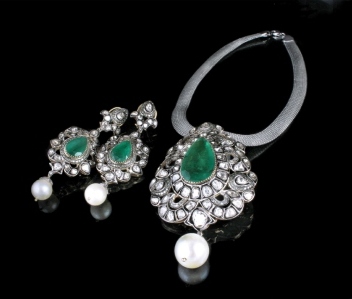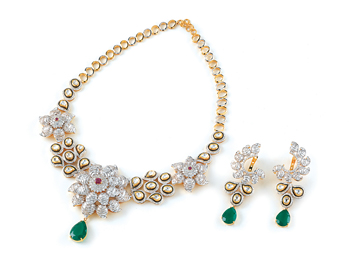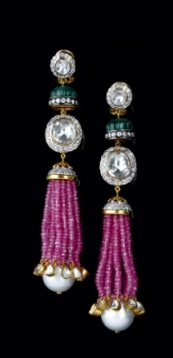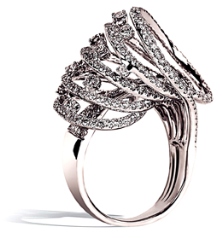Investment and Social Triggers Drive Indian Jewelry Retail
February 05, 13
The Indian jewelry-consuming market is like no other in the world. Unlike other markets, the bulk of business comes from the bridal market, followed by the socio-religious imperatives of India’s major festivals that dictate the almost necessary purchase of “auspicious” gold. But Indian weddings do not take place on random dates. Instead, they tend to be clustered within specific periods of the year – wedding seasons as they are known – that are deemed auspicious. This means that the retail jewelry market has clear highs and lows.
Despite the occasion-driven profile, however, the primary purchase driver for Indian jewelry is investment and stored value. This core element has cast Indian jewelry retail into an age-old mold that controls the way the market functions and dictates retailers’ actions. It is also explains why Indian jewelry retail has remained essentially unchanged for millennia. And why even the modern-format branded jewelry players have to adapt their strategies.
 Image: Gitanjali |
“Jewelry retail in India is a financial business. It is in the same space as the stock market, mutual funds and other financial services,” says Abhishek Gupta, president of Gitanjali Gems, which sells a variety of jewelry brands that are sold out of new-format retail outlets around the country. “The primary purchase reasons are not emotional but financial.”
Gupta argues that while there is a cultural aspect to the purchases, notably the bridal market and festivals, the “gut motivation” to buy remains financial security. For this reason, he says that jewelry is not a luxury in India, but a necessity.
This viewpoint is echoed by Sandeep Kulhalli, vice president, Retail & Marketing for India’s largest jewelry brand, Tanishq, which is owned by the giant Tata industrial group. “The occasion – a wedding or a festival – is merely the backdrop for the purchase. The prime reason for buying jewelry in India is investment. This is part of our culture – it goes back thousands of years.”
He explains that although many women are financially independent, the bride’s parents are still looking to secure their daughter’s financial future by passing on gold, mainly in the form of jewelry. This is why the bridal market is undisputedly the single biggest sales driver.
For festivals such as Dhanteras (a specific day during the festival of Diwali – the festival of lights) and Akshaya Trithiya (a festival during which it is considered auspicious to buy gold), the motivation to buy gold and jewelry is to secure the financial well-being of the family. “Because gold is so readily saleable, these purchases also form part of the family’s ‘rain money’ – instant cash in case of an emergency need,” Says Kulhalli.
Despite the uncompromising assessment of jewelry’s investment value, Indian’s do not actually view it like any other investment. It is much more meaningful. “Jewelry is truly valued by the consumer in India much more highly than anywhere else in the world,” says Gitanjali’s Gupta. “Indians are very connected to their jewelry. They hold on to it no matter what. Selling jewelry is the very last resort for any Indian consumer – it is usually dire necessity that motivates this.”
According to Kulhalli, no matter where a jeweler is located, whether it is a traditional family jeweler with somewhere single outlet or a country-spanning brand like Tanishq, which has a footprint in all the geographically different markets with their differentiated customs and customer preferences, the bridal market is the single biggest sales driver.
He says that, on average, the bridal market accounts for 60 percent of all jewelry sold in India. But it is not a unified market and nor is there a specific “bridal” product.
“Each specific geographic area has its own customs, demands and preferences. A universal design or product will not work in the different areas,” he explains.
 Image: Talwarsons |
Tanishq has developed separate bridal lines for a variety of markets in specific geographic areas around the country. “Last year we developed product lines for nine separate communities,” says Kulhalli.
But while the markets may have had their differences, there was one common characteristic: demand and preferences are very traditional and design has a much-reduced role to play.
The Gitanjali Group, with its multiple brands, including lines that are low-cost and specifically targeted at every day wear and affordable self-purchase, reports slightly different demand patterns. Gupta pegs the bridal market in India as accounting for 40 percent of total demand, with fashion or impulse buying making up the rest. Nonetheless he states emphatically that occasions account for 75 percent of the company’s demand. These events include festivals such as Diwali and Akshaya Trithiya and non-traditional occasions such as Mother’s Day.
The ebb and flow of the “seasons” of demand in jewelry retail are felt not just by the small family jewelers, but even by the bigger brands such as Tanishq. “The first quarter of the fiscal year (April-June) sees demand from rural weddings around the country and of course, Akshaya Trithiya,” says Kulhalli. “The second quarter (July-September) is difficult – there aren’t many weddings and no festivals to speak of. The third quarter (October-December) is clearly the biggest in terms of sales. It has all the major festivals including Diwali and a wedding season at the very end of the year. The fourth quarter (January-March) has more weddings and even though these taper off towards the end of the quarter, it leads into the new fiscal year’s first quarter.”
Further upstream in the production pipeline, diamond dealer and jewelry manufacturer Kanwaljit Singh of Singh Diamond, who has extensive loose diamond sales to the domestic market, particularly in the north, says even the diamond cutting and polishing business feels the seasonal pull of the Indian market. “Demand for diamonds from the domestic market is clearly impelled by the wedding seasons and festivals, no question about it. If you are manufacturing diamonds, your business planning – all the way from sourcing your rough through determining your inventory levels – is tuned to these demands. No one has steady, uninterrupted demand throughout the year.”
According to Singh, the seasonal demands and the need to be able to meet them also impact the price of rough diamonds. “You aren’t likely to bid strongly for a packet of rough if there isn’t clear demand for the polished that comes out of it at the end of the few weeks it takes to process it. Nobody wants to sit on inventory nowadays. So the seasonal demand for jewelry in India impacts a lot of things in the production pipeline including diamond prices,” he notes.
But of course, points out Singh, the rest of the big consuming markets of the world, which are all supplied by the Indian diamond manufacturing industry, have their seasonal ebb and flow, albeit nowhere near the same scale Christmas, of course generates the single largest demand spike for diamonds. But there are other smaller, occasion-driven spikes in demand – Thanksgiving, Valentine’s Day and even Mother’s Day, to name a few. “The single biggest difference is that these seasonal pulls are not the prime demand drivers the way they are here in India,” he notes.
There is, however, a transformation taking place in the Indian market. Anil Talwar of Talwarsons in Chandigarh, a seventh-generation jeweler who says his family has been in the jewelry business for almost two centuries, declares diamonds are driving that transformation. “I think the diamond jewelry market is almost totally driven by fashion,” he notes. “Half of the gold jewelry market, on the other hand, is driven clearly by the investment motive, with fashion and other drivers making up the rest.”
He goes points out that diamonds are becoming a fashion statement in India – in a big way. “If you are rich then there is no way you would not be wearing diamonds. Show me one Page Three personality [this refers to the social pages in Indian newspapers] who would not sport gorgeous diamond jewelry. Have we ever seen a woman from the well-to-do upper classes wearing silver jewelry – or no jewelry to a party?” he asks rhetorically.”
Talwar, who has an extensive upper economic echelon clientele, also thinks that social changes have redefined the Indian concept of what is termed a fashion item. “Today we have a major part of our diamond jewelry sales coming from what is called ‘party jewelry’, which is distinct from ‘routine’ diamond jewelry,” he explains.
In the past, he says, a woman used to buy “basic” jewelry in diamonds – studs and rings that she could wear day in and day out. The most she might b buy in addition would be a pair of diamond bangles or a set of more everyday jewelry. “Now in addition to this, she wants to wear exquisite diamond jewelry to parties and social functions. Even if she just goes out clubbing, she makes sure she wears something in diamonds that will get noticed. There is no cocktail party where women don’t flaunt big cocktail rings.”
 Image: Sawansukha |
Sidharthaa Sawansukha of Kolkata-based Sawansukha Jewellers also thinks major changes are taking place in the Indian market. ““Initially jewelry was associated only with weddings but now, it is now considered adornment. Consumers, especially brides, have begun showing a preference for jewelry that is a blend of the traditional and modern design. There are variations in trends and design preferences depending on the wearer’s economic status and social circle.”
Talwar says demand for diamond jewelry has been growing steadily at between 5- and 7 percent annually for the past five years. Sawansukha reports a spectacular annual growth of between 20- and 25 percent over the last five years.
Tracking those changes and knowing what Indian jewelry consumers really want and understanding the internal purchase motivators that drive buying behavior is essential to formulating retail strategy and the choice of products and services offered.
“In order to promote our sales, we offer our customers what they need and not what we have,” says Sawansukha. “Designs always take the front seat for us. No matter how westward our orientation, jewelry adornment has always been a tradition. Hence we provide an amalgamation of tradition and modern jewelry through its theme and design as well as the quality of its manufacture and finish. And while we have regular advertising – in print, outdoors, electronic and even social outreach – we still have promotional schemes offering discounts to our customers. That’s what attracts them to our product and triggers the buying decision.”
Even Talwar acknowledges that festivals and occasions generate a distinct increase in sales. He reports that this year, his sales over the all-important Diwali sales period were 18 percent over his sales during the same period last year.
But even tradition is not always what it seems. Akshaya Trithiya was a festival that was originally confined to certain areas in the south of India where it was considered it auspicious to buy gold during the festival. The World Gold Council saw an opportunity to boost sales of gold jewelry by spreading the message of an auspicious occasion to buy the yellow metal. It launched a coordinated sales and promotion campaign in conjunction with jewelry retailers around the country to do so. The results were dramatic and the festival is now a major jewelry sales driver in many parts of the country.
The sales-driving impetus that festivals provide for gold buying has also affected diamond demand from both men and women. “The drivers are similar to those that impel gold jewelry sales but much smaller in scale,” observes Sawansukh. He notes, however, that traditions in India are ancient and it isn’t easy for anything new to simply piggyback on some old and established sales driver. “Traditions cannot be created. They need to have a history.” Citing the case of Akshaya Trithaya, he notes that even though it was purposefully promoted throughout the country as a gold jewelry buying occasion, it did have a history in specific pockets in the south.
Sawansukha says people picked up on the ancient lore from the festival’s traditional markets and simply tapped into something they perceived. “It has been strongly promoted as being auspicious in order to generate sales and as people have a tendency to do what they see others doing, it has spread out of its traditional geographic base.” The festival hasn’t caught on in the Delhi area as much as it has in Kolkata.
He underlines the necessity of some sort of tradition from which to hang a sales strategy. “If you look back in history, all the jewelry that’s been described or painted features gold or jadau [traditional engraved jewelry] and other age-old techniques. We don’t see diamonds. Today, people end up buying diamond jewelry during festivals not because diamonds are auspicious or traditional but because festive season promotions offer good discounts and thus offer a consumer a good buy.” He says that this is also the reason why, no matter how much diamond jewelry people buy during a festival, they will also end up buying gold jewelry or bullion. “If we’re looking at promoting diamonds on an industry-wide basis, we should push their emotional and fashion value,” He observes.
But could the traditional patters of buying be changed? Could western-style marketing and promotions – perhaps on an industry-wide basis – bring about a major transformation in the Indian market? Ravinath Mohandas of VNM Jewel Crafts, of Ernakulam, a major city in the southern Indian state of Kerala, known for its heavy gold buying, thinks the medium-term future of Indian jewelry retail lies in leveraging the tradition of occasion-based sales.
 Image: Talwarsons |
“Akshaya Trithaya generates 4 percent of annual sales in southern markets,” he notes, adding, “that is not an insignificant number for a single festival that isn’t as big as Diwali.” (Diwali is not traditionally as major a festival in southern India as it is in the north).
“Gold and gold jewelry sales have been driven by festivals for a very long time. But if we had new, unified industry campaigns to create new buying occasions for other festivals, we would get a lift out of them as well.”
He believes that persisting with these new messages would also be one way of ensuring that sales continue over these other festivals in years to come, and would also ensure more sustained sales throughout the year. He says that the industry campaign could be for everything, including the navaratnas –nine gemstones mentioned as being precious in ancient Hindu texts.
“The buying during festivals is not just a thing with gold. And we could promote new occasions as well. Every year, Brahmins have a religious thread-changing ceremony. A unified industry message in the market could generate a unified response from consumers – the ceremony could be a great occasion to sell diamonds and other gemstones,” he posits.
The need to ensure sustained sales throughout the year is growing. Although, as Sawansukha explains, social changes have generated new “traditions”– such as diamond engagement rings – they are doing little to help sustain sales throughout the year. “As I mentioned before, people end up buying diamonds during festivals because it offers them good discounts. Almost all jewelers offer promotions during these times, so it spoils the customer for choices and also because customers postpone their buy for these festive seasons anticipating the offers.”
But it is not only jewelry that is being promoted during the major festivals. Other luxury products and services - ranging from pleasure boats, through expensive spas and exotic holidays –have adjusted the way they do business to the ethos of the Indian consuming market and heavily promote themselves during the major festivals. With big budgets – between 15- and 20 percent of their turnover – these products and services have aggressively elbowed their way forward into the Indian consumer’s consciousness. They have, as a result, also steadily eaten into jewelry’s market share.
The danger is not just these other luxury products and services. Even manufacturers of ordinary white goods manufacturers and consumer electronic appliances have tapped into the socio-religious drivers that impel sales at festivals. It is now common to see Diwali festival promotions for washing machines, refrigerators and televisions that offer consumers a bit of gold free with the purchase. With the auspicious acquisition of the yellow metal done along with the purchase of a useful appliance, the consumer is much less motivated to walk into a jewelry retail showroom just to make a festival purchase.
This competition now means that jewelry retailers routinely promote their year round, with more emphasis on the festivals. Talwar is one of them. “We advertise and promote all year round, with a little bit more of a concentrated effort during a festival like Diwali. We have been doing this for a long time now and it makes a difference. We stay in the consumer’s consciousness.” He says his advertising and promotion spans a variety of media. These efforts are then buttressed by in-store promotion initiatives – again something that is done year round.
 Image: Sawansukha |
A major difference in 2012, Talwar says, was that his firm launched a serious initiative via social media. “We take Facebook very seriously now,” he says. “With a fan following of over 30,000, we have a great outreach medium on a daily basis.”
Sawansukha said that over the 2012 Diwali season, his firm promoted its product as usual through a combination of advertising, in-store promotions and personal outreach initiatives.
Nitin Khandelwal of Khandelwal Jewellers from the western Indian city of Akola, while observing that more Indians are now buying diamonds over the festival season, said that the sort of generic promotions that De Beers launched in the country a couple of decades ago to ignite demand was now sorely needed. “We had a good festival season and we have continued strong diamond sales throughout the year. But a unified industry campaign telling consumers that a diamond is forever would result in a major boost in demand,” he said.
Whether or not a unified industry campaign is developed, Indian jewelry retail is undergoing some fundamental transformations that are being driven by social changes and altered perceptions of what is valuable. The next few years are likely to see changes in the market that one couldn’t have even dreamt of just a few years ago. The tide of consumer demand is now reshaping the very core of Indian jewelry retail.
A $92 Billion Market?
There are no official figures to enable a full estimation of the size of the Indian jewelry retail market because a staggering number of jewelry sales transactions take place without an invoice. But by a process of reverse estimation, Abhishek Gupta, president of Gitanjali Gems, figures the total market to be in the region of Rs.5 trillion ($92 billion).
“Look at it from the bottom up,” he says. “Last year, we imported 1,000 tons of gold, which can be estimated at a value of around Rs.2.75 trillion ($51 billion). Add Rs.250-Rs.300 billion ($4.6-$5.5 billion) in polished diamonds; another similar amount in the value of silver and colored gemstones and you get a figure of around Rs.3.5 trillion ($64.4 billion) in simply the intrinsic commodity value of the materials.”
Having established a base intrinsic value, Gupta extrapolates the retail value of the Indian jewelry market. “If we remove 35 percent of this value for straightforward investment in bullion or diamonds and gemstones, we’re left with Rs.2.5-Rs.Rs.3 trillion ($46-$55 billion) in intrinsic value for jewelry alone. Slap on between 25- and 30 percent in average mark-ups for retail and we’re looking at Rs.4 trillion ($73.6 billion) in retail value at a conservative estimate. I think the true figure is closer to Rs.5 trillion and possibly even higher.”